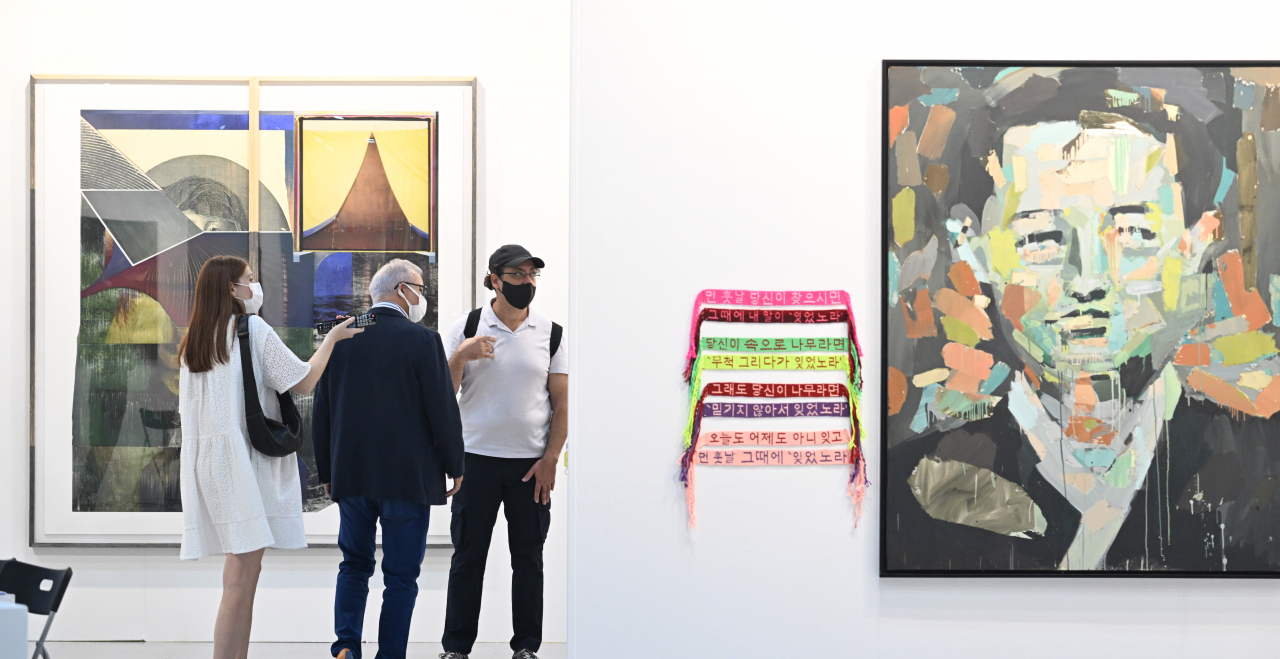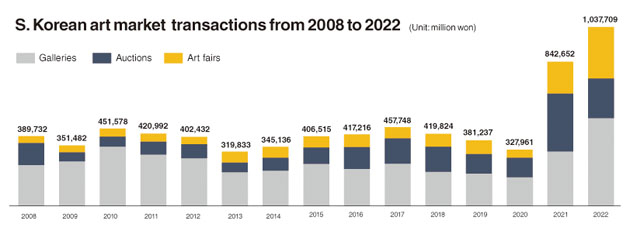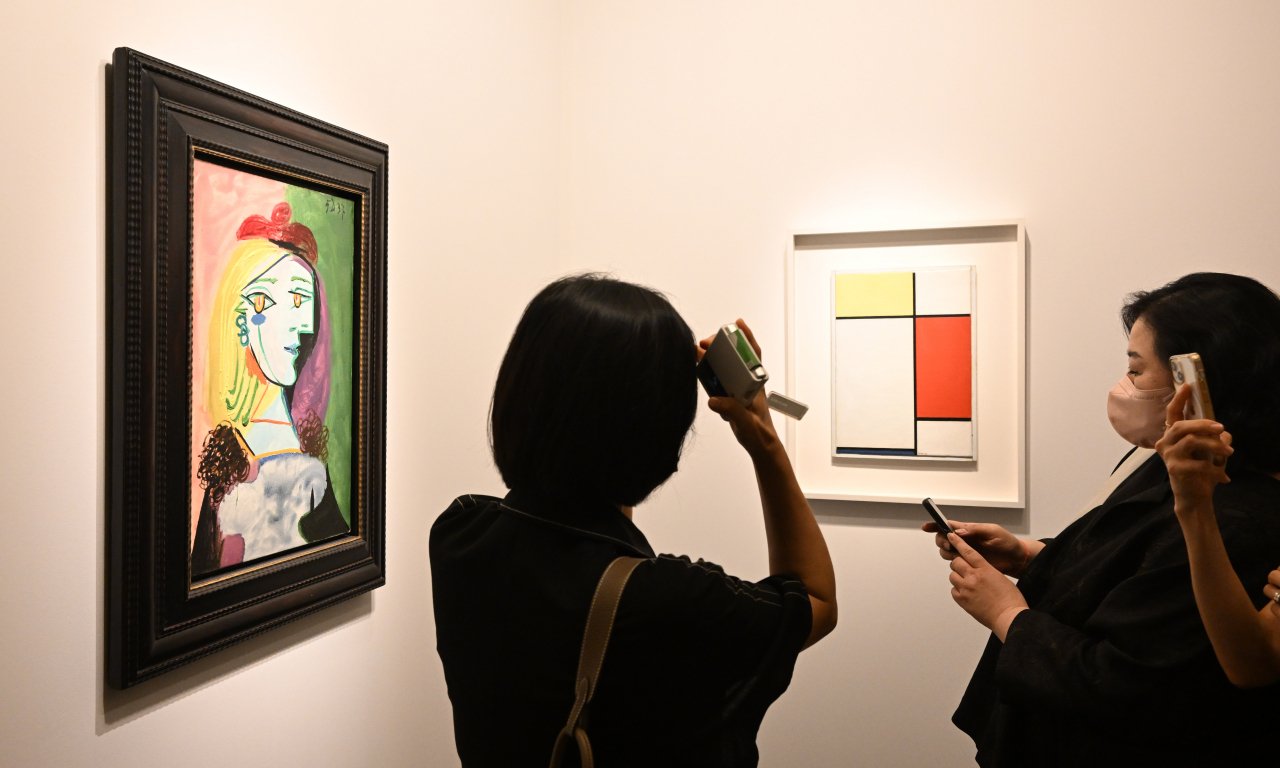 |
Visitors view artwork at Kiaf Seoul on Sept. 2, 2022 at Coex in Seoul. (Im Se-jun/The Korea Herald) |
The Korean art market has enjoyed an unprecedented period of growth over the past couple years, seeing a record-breaking number of visitors to successive art fairs, including last year's inaugural Frieze Seoul.
The timing also coincided with international galleries opening or expanding in Seoul, lending credence to the claim that the capital was on its way to becoming the next hub of the Asian art market.
The value of the Korean art market surpassed one trillion won for the first time. Before it saw such the vitality, transactions had remained under 500 billion won ($400 million) nearly for two decades, according Culture Ministry data.
 |
S.Korean art market transactions from 2008 to 2022(The Korea Herald, Ministry of Culture, Sports and Tourism) |
The value of the art market skyrocketed to 842 billion won in 2021 then hovered over one trillion won last year. Considering the fact that the transaction does not include the sales figure from the inaugural Frieze Seoul, which does not release sales reports, last year’s transactions is estimated to exceed the reported figure.
Toward the end of 2022, however, players in the art market started to notice the decline in transactions due to a global economic slump.
The sign was evident in the auction market. In the fourth quarter of last year, the country’s largest auction houses -- Seoul Auction and K-Auction -- saw a 61 percent decrease in sales from winning bids compared to the same period in 2021, according to a report by Korea Art Authentication Appraisal.
Many galleries -- where half of last year's 1 trillion won in transactions occurred -- have switched to a cautious mode, bracing for a possible change in the coming years as people close their wallets in anticipation of a possible global economic recession. The lowered value of the won against the US dollar also hinders transactions in art work, according to multiple gallerists based in Seoul.
“It is true that we have been seeing a slowdown in transactions in recent months. We are keeping an eye on the market situation,” said Park Kyung-mee, president of PKM Gallery, one of the leading galleries in Seoul.
‘It’s different this time’
Back in 2008, South Korea’s art market, then in the midst of an upswing, was hammered by the global economic recession brought on by the bankruptcy of Lehman Brothers in September 2008.
“The Korean art market reached a peak at the end of 2007, (…) Korea’s representative art fair, Kiaf Seoul, had grown an average of 209 percent annually for three years. The number of auction houses mushroomed during the time,” So Jin-su, a professor at Kangnam University wrote in the 2009 paper, “The Korean Art Market and Business Cycles between 2005 and 2009.”
The art market fever back then aligned with the booming Korean economy from 2003 to 2007. The growth abruptly halted in 2008 due to the global economic situation and the art market freezing continued through early 2009, he wrote.
 |
Visitors to the inaugural Frieze Seoul take photographs of artwork on Sept. 2, 2022 at Coex in Seoul. (Im Se-jun/The Korea Herald) |
While concerns over another possible slump looms over the art scene, many gallerists remain confident, stressing that the current situation is different from that of 2008.
Hakgojae Gallery President Woo Chan-kyu, who has witnessed the ups and downs in the market over past decades since opening the gallery in 1988, pointed out that the Korean art market has a lot of room to grow considering the size of the country's economy, which is the fourth largest in Asia.
“While the country’s art market has reached 1 trillion won, that is less than sales at mid-sized companies. Works by Korean artists are still undervalued as well as in price. The Korean art market still has a lot of potential to grow," Woo said.
He also noted that the Korean art market today is driven by young people. “We have a strong influx of young collectors this time and their enthusiasm will not dissipate right away. Also the gross national income has increased compared to 2008. I expect the Korean art market will steadily rise, drawing an upward curve,” he added.
Major Korean galleries that participated in Art Basel Miami Beach that ran from Nov. 29 to Dec. 1 said they witnessed vigorous interest in Korean artists.
“Although it is said that the art market is declining globally, we saw a huge interest in Korean artists we brought to the art fair, including the avant-garde artists from the 1960s to 1970s. We definitely see Korean art attracting attention in the global art scene,” a Gallery Hyundai staff told The Korea Herald.
In September, the Guggenheim Museum in New York City will bring together Korean avant-garde artists for the first time in a show titled “Experimental Art in South Korea, 1960s-70s” in collaboration with the National Museum of Modern and Contemporary Art, Korea. It will be the first exhibition in North America to shed light on the experimental artists who pushed artistic boundaries decades ago, according to the museum.
German gallery Koenig Seoul is one of the foreign galleries that have opened in Seoul in recent years. Managing director Soo Choi said Korean art market is headed in the right direction with the primary market becoming more active last year compared 2021 when the auction market was overheated.
Emma Son, senior director of Lehmann Maupin, said she is in a “watch-and-see mode” this year, but shrugged off worries about Korea art market. She experienced the turbulence in the art market back in 2008. The art market will mature after all the ups and downs, she said.
“The year 2021 was the best year. The market started to falter late last year. But it is okay -- we are seeing many young people visiting museums, and I see international attention on the Korean art scene is still solid," Son said, explaining that the growing presence of international galleries in Seoul reflects such attention.
European gallery Thaddaeus Ropac, which opened in Seoul in October 2021 is introducing talented artists both in Seoul and abroad unperturbed by the concerns about a possible contraction in the Korean art market. On Jan. 6, the gallery opened a group exhibition of Koreans and Korean diaspora whose works reflect the Korean artistic, cultural and social landscape.
“The Korean art market’s pie has grown bigger now. It is time for a healthy collecting culture to take root. I am optimistic about the market this year,” said Hwang Kyu-jin, executive director of Thaddaeus Ropac in Seoul.
By Park Yuna (yunapark@heraldcorp.com)







![[Today’s K-pop] Blackpink’s Jennie, Lisa invited to Coachella as solo acts](http://res.heraldm.com/phpwas/restmb_idxmake.php?idx=644&simg=/content/image/2024/11/21/20241121050099_0.jpg)